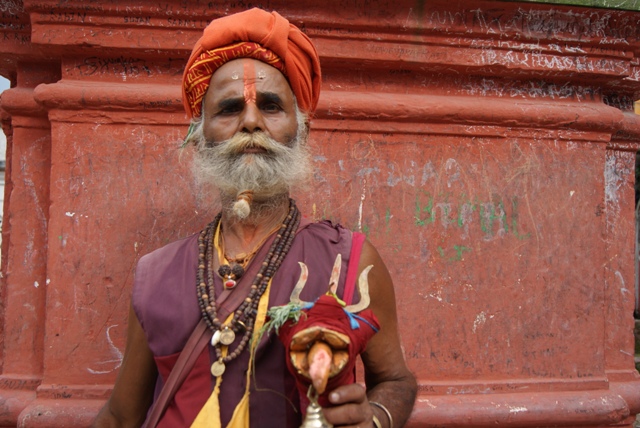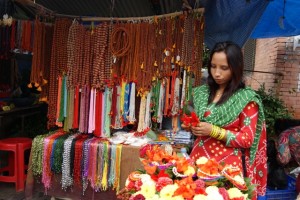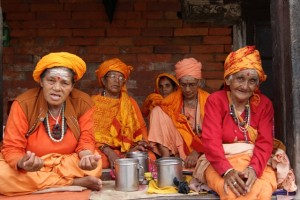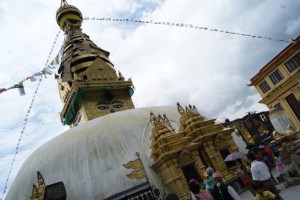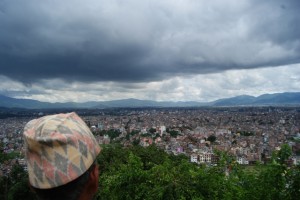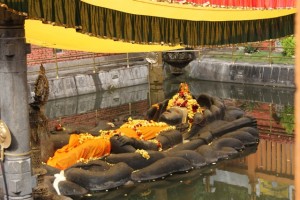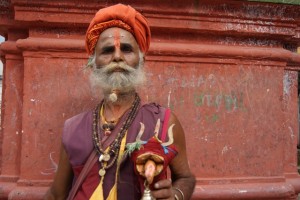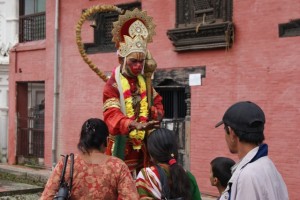 Lord Shiva, revered as the most benevolent god in the valley is depicted here with four arms and three eyes. One of his hands holds the trident which symbolises his three-fold manifestations – that of the creator, keeper and destroyer. Many childless parents also pray to the Nandi or bull, his vehicle, believed to be a symbol of fertility. Shiva is at the same time, the creator and the destroyer. He is Mahadeva, the Great god, Bhairav, The Cruel or Pashupati, the Lord of the Beasts. A lingam or the phallus is worshipped in this temple, also called ‘The Temple of Living Beings’ symbolising Lord Shiva. The Pashupatinath Temple is by the banks of the Baghmati River which is lined with cremation ghats and pilgrim guesthouses or dharamsalas. This cremation ghat is called the Bhasmeshwar Ghat and is the most-used cremation site in the Kathmandu Valley. Till the early 20th century, sati – the practice of married women following their husbands in death through the funeral pyre – used to be performed here. There is also a separate cremation ghat for the royal family called the Arya Ghat. Despite the state of the water, couples still bathe here together in the belief that they will be together again in their next life as well. Believers also take ritual purification bathes in these waters.
Lord Shiva, revered as the most benevolent god in the valley is depicted here with four arms and three eyes. One of his hands holds the trident which symbolises his three-fold manifestations – that of the creator, keeper and destroyer. Many childless parents also pray to the Nandi or bull, his vehicle, believed to be a symbol of fertility. Shiva is at the same time, the creator and the destroyer. He is Mahadeva, the Great god, Bhairav, The Cruel or Pashupati, the Lord of the Beasts. A lingam or the phallus is worshipped in this temple, also called ‘The Temple of Living Beings’ symbolising Lord Shiva. The Pashupatinath Temple is by the banks of the Baghmati River which is lined with cremation ghats and pilgrim guesthouses or dharamsalas. This cremation ghat is called the Bhasmeshwar Ghat and is the most-used cremation site in the Kathmandu Valley. Till the early 20th century, sati – the practice of married women following their husbands in death through the funeral pyre – used to be performed here. There is also a separate cremation ghat for the royal family called the Arya Ghat. Despite the state of the water, couples still bathe here together in the belief that they will be together again in their next life as well. Believers also take ritual purification bathes in these waters.
Built along the Nepalese pagoda style of architecture, beautifully carved wooden rafters or tundal, multiple level roofs with copper and gold covering, the Pashupatinath Temple is where history and mythology goes hand in hand. The often conflicting and multiple versions of the origins of the famed temple seemed to have only added to the mystic allure of the shrine. While on one side there were those seeking blessings for the journey of life. On the other side were those who had embarked on a different journey altogether. The Pashupatinath Temple embodies the contrasts Nepal is famed for, with a profound grandeur.
Nepalese legends believe that the country was formed when Manjushree, an avatar of Buddha, came to a holy lake to worship the blue lotus, which contained the eternal flame of the Primordial Buddha. To make passage for the devotees easier, he drained the lake which revealed a fertile valley which eventually became Nepal. The site of the Swayambhunath stupa marks the place where the original island stood. The eyes of the Buddha that gazes in all directions denote that this was an important centre of Buddhist learning for several centuries. The gigantic, white hemispherical mound of the Swayambhunath represents creation and is designed as per certain rigid parameters. The 13 gilded rings on the spire represent the 13 degrees of knowledge required for enlightenment and finally to nirvana, represented by the umbrella at the top of the stupa. Buddhaneelakantha, nine kilometres from Kathmandu, is one of the earliest settlements during the Licchavi period. This is a little village that sits comfortably at the foot of the Shivpuri Hill – a 2732-metre summit which is a hot spot for trekkers, bird watchers and picnickers. Here, the monolithic black statue of the reclining Vishnu rests on a bed of snakes. Vishnu is part of the Hindu trinity of Brahma, Vishnu and Shiva and is most revered by many Hindus as he is the creator and the keeper of the world. He has a thousand avatars among the more popular ones are that as the frolicking god Krishna and as Narayana – as he is depicted here, floating in the primeval ocean, resting on a bed of snakes. Some 1500 years ago, during the reign of the Licchavi kings, a massive five-metre rock was dragged and placed in this pond at the foot of the Shivpuri Hills which was sculpted by master craftsmen into a literal translation of Vishnu as Narayana. Modern folklore says that no Nepali King ever visits the Buddhaneelakantha as it supposedly led to a premature death. A drastic belief perhaps, still one of those arcane, archaic ones which keep adds to and keeps alive the enigma that is Nepal.

